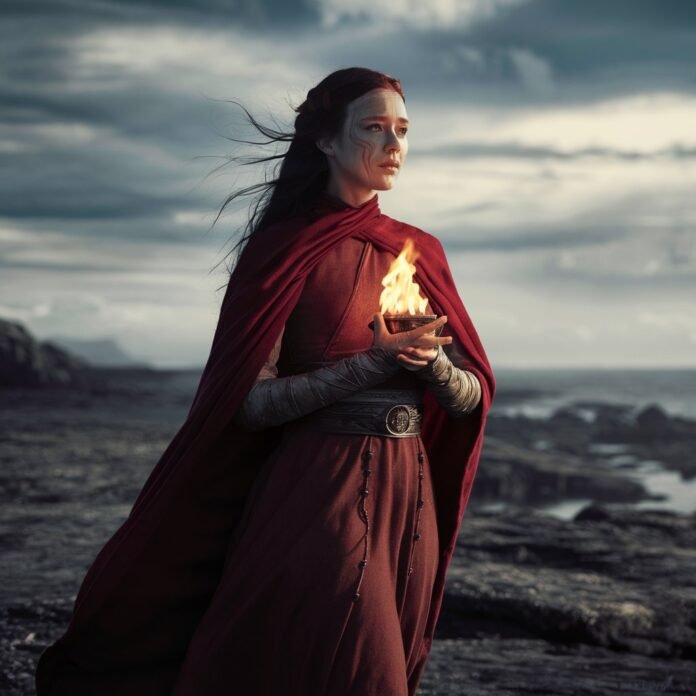Introduction
Melisandre, the Red Priestess of R’hllor, was one of Game of Thrones’ most mysterious and polarizing figures. With her striking crimson robes, piercing gaze, and unwavering faith in the Lord of Light, she wielded both divine power and dangerous influence. From resurrecting Jon Snow to birthing a shadow assassin, her actions shaped the fate of Westeros—yet her true motives remained shrouded in prophecy and deception. This article delves into Melisandre’s role in the series, her magical abilities, controversial choices, and the lingering questions about her legacy.
1. The Power of the Red Priestess: Magic, Prophecy, and Fanaticism
Melisandre’s introduction in Game of Thrones established her as a formidable mystic, capable of miracles and dark sorcery. Her belief in Stannis Baratheon as the prophesied “Prince That Was Promised” drove much of her early arc, leading her to perform blood magic—most infamously, the shadow creature that killed Renly Baratheon. Unlike other magic-users in the series, Melisandre’s power came from unwavering devotion rather than ancient knowledge or bloodline. Her visions in the flames, though sometimes misinterpreted, proved crucial to major events, including Jon Snow’s resurrection. Yet her fanaticism also blinded her, as seen when she endorsed burning Shireen alive—a decision that ultimately destroyed Stannis’s cause. Her abilities raised profound questions: Was she truly a divine messenger, or a zealot manipulating events to fit her own narrative?
2. Melisandre’s True Age and the Reveal of Her Hidden Form
One of the most shocking moments in Melisandre’s storyline came in Season 6, when she removed her enchanted ruby choker, revealing her true form: an ancient, withered woman. This revelation hinted at centuries of life, suggesting she had prolonged her existence through dark magic. The twist added depth to her character, explaining her confidence, her fearlessness in the face of death, and her cryptic remarks about “seeing the future in the flames for many years.” It also paralleled the books, where her agelessness is subtly implied. This moment reshaped how viewers perceived her—no longer just a priestess, but a near-immortal being whose true motives might have been obscured by time itself.
3. From Villain to Redeemer: Melisandre’s Complex Arc
Melisandre’s journey in Game of Thrones was one of the most morally ambiguous. Initially, she appeared as a sinister figure, manipulating Stannis and endorsing human sacrifice. Yet, after his downfall, she played a pivotal role in resurrecting Jon Snow, proving that her magic could serve a greater good. Her final act—riding to Winterfell to aid in the battle against the Night King—showed a measure of redemption. Before facing her own death at dawn, she ensured the living had fire weapons and courage, declaring, “The night is dark and full of terrors, but the fire burns them all away.” Her arc left fans divided: Was she a self-serving manipulator, or did she genuinely believe in a higher purpose?
4. Book vs. Show: How Game of Thrones Changed Melisandre’s Story
George R.R. Martin’s portrayal of Melisandre in A Song of Ice and Fire differs in key ways from the TV adaptation. In the books, she is more enigmatic, with fewer outright villainous traits, and her magic is subtler. The show streamlined her role, making her more directly responsible for major events (like Shireen’s burning, which in the books hasn’t yet happened). Additionally, her relationship with Jon Snow is far more developed in the novels, where she plays a larger part at the Wall. These changes raise interesting questions about how TV adaptations simplify—or exaggerate—characters for dramatic effect.
5. Melisandre’s Legacy: Faith, Power, and the Price of Prophecy
By the end of Game of Thrones, Melisandre’s impact was undeniable. She brought Jon Snow back to life, influenced the Great War, and embodied the dangers of religious extremism in a world where gods may or may not be real. Her final walk into the snow at dawn, willingly accepting death after fulfilling her purpose, was a poetic end for a character who always believed in destiny. Yet, her legacy remains controversial—was she a force of salvation or destruction? Her story forces viewers to grapple with faith, free will, and whether prophecy is a guiding light or a self-fulfilling curse.
Conclusion: The Eternal Flame of Melisandre’s Mystery
Melisandre was more than just a priestess; she was a symbol of the blurred line between divine intervention and human manipulation. Her presence in Game of Thrones added layers of mysticism, moral ambiguity, and haunting beauty to the series. Whether seen as a villain, a tragic figure, or an instrument of fate, she remains one of the show’s most unforgettable characters—one whose influence lingered long after she turned to dust in the morning light.



